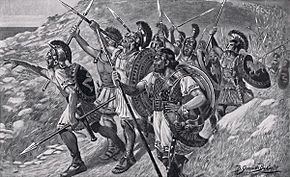 | ||
Similar Peltast, Immortals, Ancient Macedonian army, Athenian military, Spartan army | ||
The Ten Thousand (Ancient Greek: οἱ Μύριοι) was a force of mercenary units, mainly Greek, employed by Cyrus the Younger to attempt to wrest the throne of the Persian Empire from his brother, Artaxerxes II. Their march to the Battle of Cunaxa and back to Greece (401–399 BC) was recorded by Xenophon (one of their leaders) in his work, The Anabasis.
Contents
Campaign
The "ten thousand" marched inland and fought the Battle of Cunaxa and then marched back to Greece during the years 401 BC to 399 BC. Xenophon stated in The Anabasis that the Greek heavy troops scattered their opposition twice during the battle; only one Greek was even wounded. Only after the battle did they hear that Cyrus had been killed, making their victory irrelevant and the expedition a failure.
The "ten thousand" were in the middle of a very large empire with no food, no employer, and no reliable friends. They offered to make their Persian ally Ariaeus king, but he refused on the grounds that he was not of royal blood and so would not find enough support among the Persians to succeed. They offered their services to Tissaphernes, a leading satrap of Artaxerxes, but he refused them, and they refused to surrender to him. Tissaphernes was left with a problem; a large army of heavy troops, which he could not defeat by frontal assault. He supplied them with food and, after a long wait, led them northwards for home, meanwhile detaching Ariaeus and his light troops from their cause.
The Greek senior officers accepted the invitation of Tissaphernes to a feast, where they were made prisoner, taken up to the king, and decapitated. The Greeks then elected new officers and set out to march northwards to the Black Sea through Corduene and Armenia. Xenophon records the joyful moment when the "ten thousand" (by then actually far fewer) finally saw the sea, signifying their escape, whereupon they shouted Thalatta! Thalatta! ("The Sea! The Sea!").
Order of battle
According to Xenophon, the Ten Thousand were composed of:
In addition, they were backed up by a fleet of 35 triremes under Pythagoras the Spartan and 25 triremes under Tamos the Egyptian, as well as 100,000 Persian troops under Ariaeus the Persian (although Xenophon lists them as 100,000, most modern historians believe Ariaeus' troops were only around 20,000).
Until shortly after the Battle of Cunaxa, the Spartan general Clearchus was recognized as the commander of the army. When Tissaphernes arrested and executed Clearchus, Proxenus, Menon, Agias (possibly the same person as Sophaenetus), and Socrates, their places were taken by Xenophon, Timasion, Xanthicles, Cleanor, and Philesius, with the Spartan Chirisophus as the general commander.
When the Ten Thousand started their journey in 401 BC, Xenophon tells us that they numbered around 10,400. At the time Xenophon left them two years later, their number had dwindled to just under 6,000.
